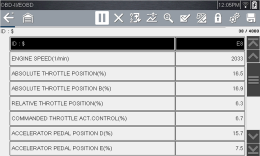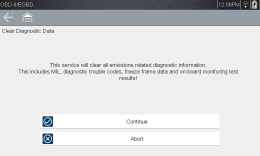OBD-II Service Modes
Home Screen: OBD-II/EOBD > OBD Direct > OBD Diagnose > Start Communication > ($01) Display Current Data
Use this mode to view the current powertrain PIDs. This data is displayed unmodified as transmitted by the module(s). The main body of the screen has two columns; the left-hand column is a description of the PID and the right-hand column is the value or state. Viewing options and operations are the same as the Scanner function.
OBD-II/EOBD Codes have a priority according to their emission severity. The priority of the code determines the illumination of the MIL and the code erase procedure. Priority rankings vary across vehicle manufacturers, makes and models.
Create a custom PID list to increase the display refresh rate / response time of displayed PIDs.
Current data display
Home Screen: OBD-II/EOBD > OBD Direct > OBD Diagnose > Start Communication > ($02) Display Freeze Frame Data
Freeze frame data provides a “snapshot” of critical PIDs at the approximate time the DTC was set.
This mode is used to display freeze fame data for any stored emission related diagnostic trouble codes (DTCs). In most cases the stored frame is the last DTC that occurred. Certain DTCs, those that have a greater impact on vehicle emissions, have a higher priority. In these cases, the highest priority DTC is the one for which the freeze frame records are retained.
Home Screen: OBD-II/EOBD > OBD Direct > OBD Diagnose > Start Communication > ($03) Display Trouble Codes
This mode displays stored emission related DTCs. The display is similar to the Scanner function code display, but the list does not include enhanced DTCs.
Home Screen: OBD-II/EOBD >OBD Direct > OBD Diagnose > Start Communication > ($04) Clear Emissions Related Data
Clear Codes erases all stored data, including any enhanced codes and freeze frame information.
This mode is used to clear all emission related diagnostic data, such as DTCs, freeze frame data, and monitor test results This also resets monitors to Not Ready and turns the MIL off.
| 1. | Select Clear Emissions Related Data from the menu. |
A confirmation message displays to help prevent loss of any vital data.
Clear codes confirmation message
| 2. | Continue from the confirmation message. |
The screen updates several times as the memory is erased, then a “data has been cleared” message displays.
| 3. | Select Continue to return to the Select Service menu. |
This option opens a submenu of services for to display parameters and test results from various sensors, monitor test results, and a record of DTC setting conditions detected during the last drive cycle. The submenu includes:
($05) Oxygen Sensor Monitoring
Home Screen: OBD-II/EOBD > OBD Direct > OBD Diagnose > Start Communication > ($05) Oxygen Sensor Monitoring
This option provides test results for checking the integrity of the oxygen (O2) sensors for non-CAN Bus vehicles. Making a selection displays all of the pertinent O2 sensor parameters for the specific test. The test identification (ID) displays at the top of the data list. Typically this mode will not be available when testing a CAN Bus equipped vehicle, as the applicable data is provided in mode six.
($06) On-board Monitored Systems
Home Screen: OBD-II/EOBD > OBD Direct > OBD Diagnose > Start Communication > ($06, 07) Display Test Param./Results > ($06) On-Board Monitored Systems
This mode provides monitored system test results. The available data is for specific systems and components that the on-board diagnostic system monitors continuously, such as misfire, or non‑continuously, such as the catalyst system. Mode $06 information may vary between make/model/year and may require information from the OEM in order to interpret the results.
To find OEM mode 6 information, check the OEM service information. As an alternate source visit NASTF.org
For CAN Bus equipped vehicles, OEMs typically define the different test results using Monitor ID's (MID) numbers (e.g MID $39, $A2), and Component IDs (CID). Each MID and CID may provide test result values and fault limits that can help you identify which monitor has failed and help validate the repair after completion.
For pre-CAN Bus equipped vehicles, OEMs typically defined the different test results using Test ID (TID) and Component IDs (CID). These were used in the same manner as described above for CAN Bus vehicles.
($07) DTCs Detected During Last Drive
Home Screen: OBD-II/EOBD > OBD Direct > OBD Diagnose > Start Communication > ($06, 07) Display Test Param./Results > ($07) DTCs Detected During Last Drive
This mode is also commonly known as "Pending Codes". Mode seven provides a record of pending DTCs that set during the last completed drive cycle. Pending DTCs are also referred to as "two-trip" codes, where at the initial malfunction the module stores the code, but does not activate the MIL. Only if the same malfunction happens again will the MIL activate and the code be stored in the mode three list. This can be helpful when verifying a repair, by checking the results after a drive cycle.
Home Screen: OBD-II/EOBD > OBD Direct > OBD Diagnose > Start Communication > ($08) Request Control of On-board System
This mode provides bidirectional control of applicable emissions related components. When supported, this typically allows the diagnostic tool to control the operation of the EVAP vent and purge solenoids.
Home Screen: OBD-II/EOBD > OBD Direct > OBD Diagnose > Start Communication > ($09) Read Vehicle Identification
This mode provides vehicle-specific information from the applicable emission related modules, such as the vehicle identification number (VIN), and module calibration, verification numbers (CVN). Select a menu item to retrieve the information. This information can be helpful when reprogramming is needed and in verifying if the module(s) match the actual vehicle VIN and if their calibration version is current.
Home Screen: OBD-II/EOBD > OBD Direct > OBD Diagnose > Start Communication > ($09) In-use Performance Tracking
This option displays the “In-use Performance Tracking” of data. This is a record of the number of times each of the monitor tests have been completed.
Home Screen: OBD-II/EOBD > OBD Direct > OBD Diagnose > Start Communication > ($0A) Display Permanent Trouble Codes
Mode ten displays a record of any “permanent” codes. A permanent status DTC is one that was severe enough to illuminate the MIL at some point, but the MIL may not be on at the present time.
Whether the MIL was switched off by clearing codes or because the setting conditions did not repeat after a specified number of drive cycles, a record of the DTC is retained by the ECM. Permanent status codes automatically clear after repairs have been made and the module successfully completes it's monitor testing procedure. The criteria for successful monitor testing may include completion of multiple successful drive cycles, or a universal trip drive pattern, refer to OEM service information for details.






